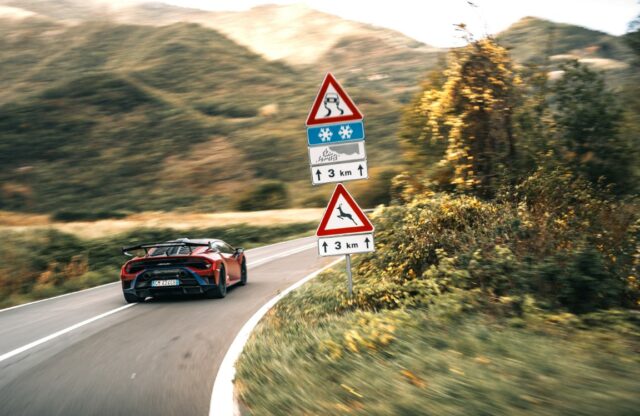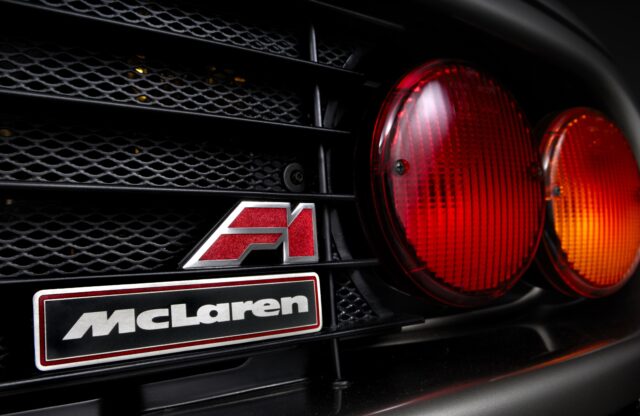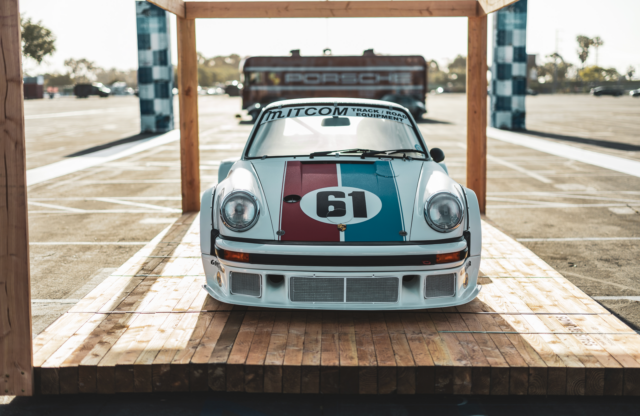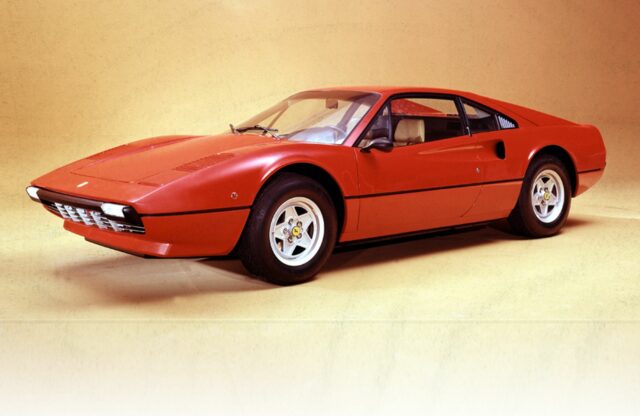WORDS: ELLIOTT HUGHES | PHOTOS: AUTHOR AND LAMBORGHINI
Even though it’s nighttime, it’s almost impossible to ignore the four serrated silhouettes parked line abreast outside the hotel. Each sports vibrant paintwork and represents a distinct variant of a soon-to-be-replaced supercar: the Lamborghini Huracán.
I’m one of four journalists invited by Lamborghini to rotate through the driver’s seat of each Huracán for a day-long adventure through Italy. Our journey spans 350km from Sant’Agata, the marque’s hometown, to the Vallelunga Circuit for the Lamborghini Super Trofeo World Finals – a one-make series showcasing Huracán race cars.
The four-car fleet represents the spectrum of the current Huracán range. There’s a Tecnica coupé, a striking Evo Spyder and a race-bred STO brandishing an imposing rear wing. For my money, it’s the last car – a go-anywhere Sterrato model – that is the craziest of them all.
Each of us has been allocated a specific car for the four segments of our pilgrimage to Vallelunga. There’s clearly no proverbial short straw here, and it’s obvious that this will be a very special day. Particularly as the realisation has dawned on the entire group that this could be our final opportunity to revel in the experience of a new, V10-powered Lamborghini. Better make the most of it.
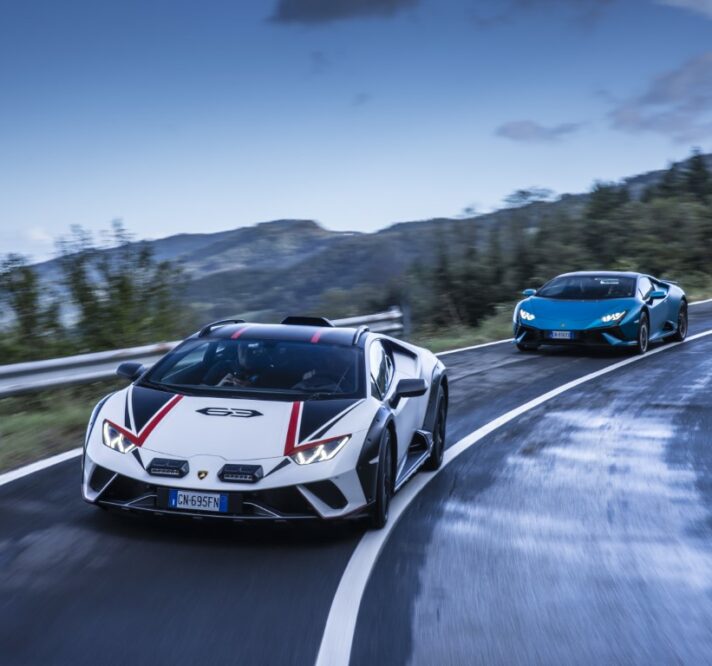
The V10 emits an operatic wail that builds to a deafening crescendo as it reaches its 8500rpm red line
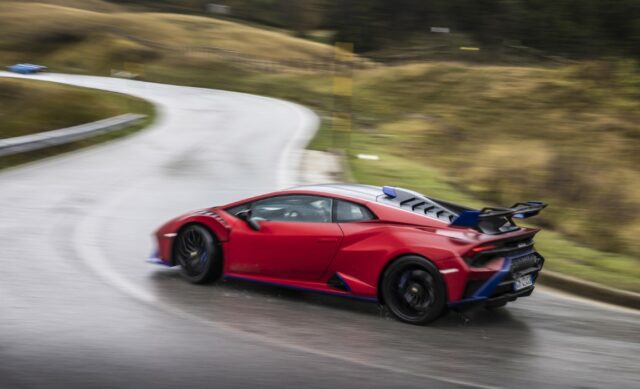
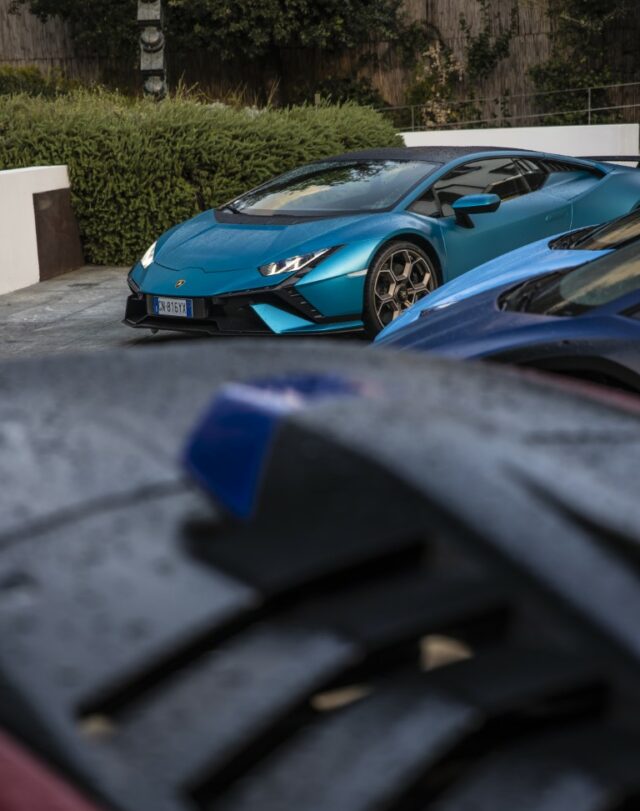
Affable Lamborghini PR Enrico informs me that I’ll be spending the first 109km stint behind the flat-bottomed steering wheel of the Huracán Evo Spyder. The first step is to find the fighter jet-inspired ignition button embedded in the centre console, jab it and hear the 5.2-litre normally aspirated V10 explode into life with a theatrical bark. With the engine idling, I adjust the seat, yet find myself sitting a touch too high even in its lowest setting.
Next, I immediately start retracting the roof despite the late-November chill, while quietly hoping I’m not committing a similar cultural faux pas to ordering a post-lunch cappuccino. If it is, fellow motorists crawling through rush-hour traffic certainly do not let on.
Unsurprisingly, I do feel rather conspicuous driving a convertible Lamborghini. Other drivers point, take photos and even undertake to get a better look. This is a novelty at first, but it begins to wear thin quite quickly. Even so, being papped in rush-hour traffic provides the perfect opportunity to rattle through the car’s impressive spec sheet.
First released back in 2020, the Huracán Evo Spyder applies the powertrain and dynamic upgrades of the Huracán Performante coupé to a convertible bodystyle. The upgrades include the previously optional variable-ratio dynamic steering rack and rear-wheel-steering system first seen in the Aventador S, as well as a fresh intake manifold, a lighter exhaust system and new titanium valves with more lift.
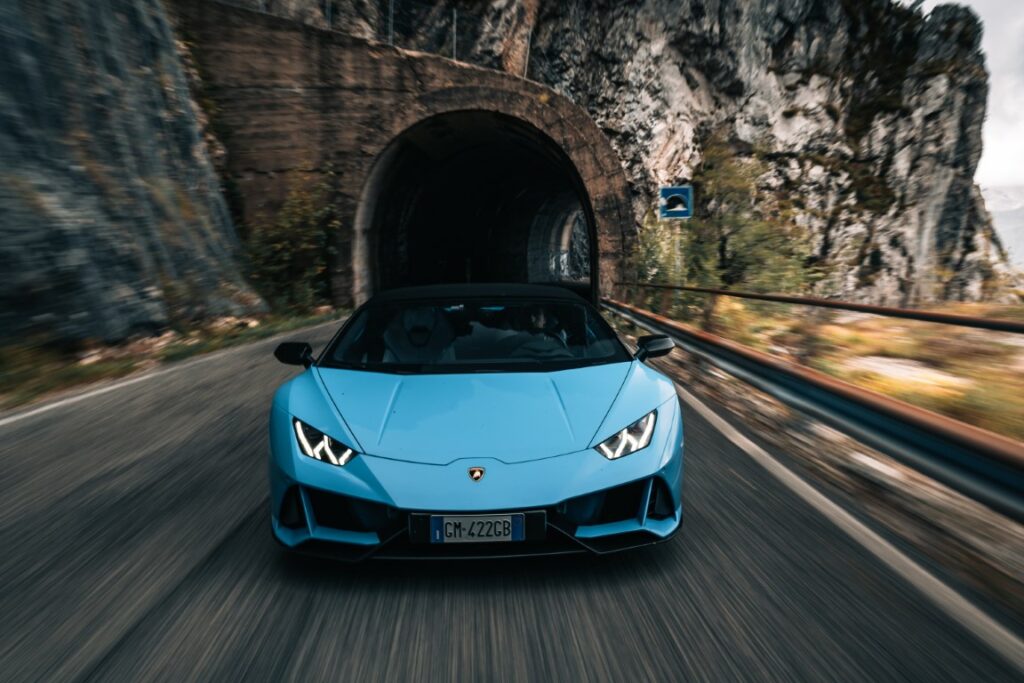
The engine upgrades mean the Evo Spyder sends 631bhp and 443lb ft of torque through a seven-speed dual-clutch transmission to all four wheels, while torque vectoring and second-gen magnetorheological dampers add agility. Weighing in at 1542kg dry, the car despatches 0-62mph in just 3.1 seconds, and tops out at 202mph. In other words, it’s fast.
Mercifully, the traffic begins to dissipate about 30 minutes into the journey. An oncoming tunnel with no cars in either lane is my first invitation to plant the aluminium throttle pedal into the carpet. The V10 emits an operatic wail that builds to a deafening crescendo as it reaches its 8500rpm redline.
Then, right foot off the pedal, wait, and downshift with the left paddle. The car automatically blips the throttle, and a gratuitous cacophony of pops and bangs blare from the exhaust pipes behind me, reverberating off the tunnel’s walls. This never gets old.
The sound is even more theatrical once I flick the ANIMA (Adaptive Network Intelligent Management) switch from Strada (road) into either Sport or Corsa modes. Aside from the noise, both settings sharpen the throttle response and electrically power-assisted steering, stiffen the dampers and increase the aggressiveness of the gearchanges. The system works well, albeit with the drawback of there being no option to tailor individual settings. The finicky motorcycle-style indicator, headlight and wiper controls on the steering wheel are another gripe.
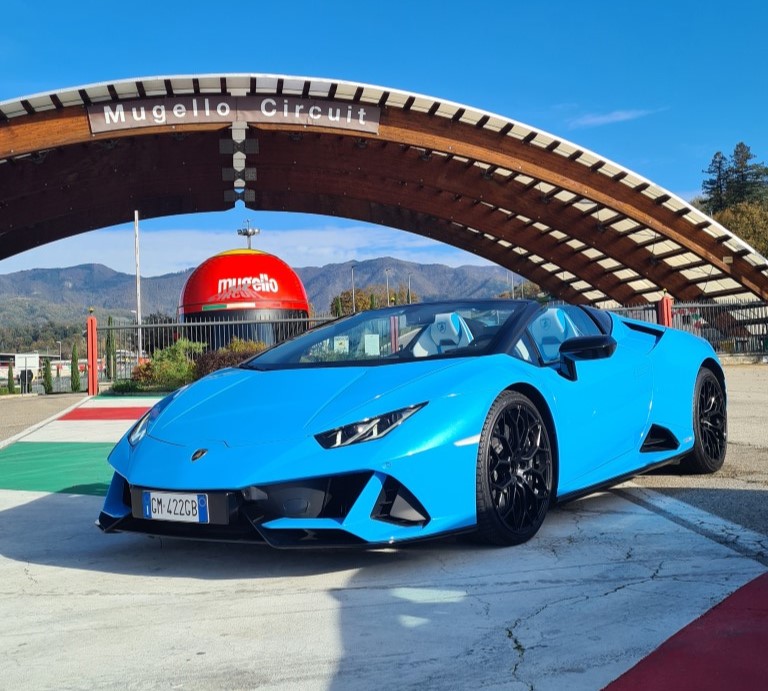
Although the majority of the first stint has been spent on the autostrada, a twisty section of road before the first stop at the Mugello Circuit reveals a neutral balance, agility and a wealth of grip from the four-wheel-drive system.
After a quick stop for a photoshoot outside Mugello, I trade the Evo Spyder key for that of the Huracán Tecnica coupé for the next part of the journey. This time, we’re heading 121km through Firenze, and onto the beautiful medieval town of Volterra. Happily, the mayor of Volterra has allowed us to park in the stunning Piazza del Priori plaza in the heart of the town.
First unveiled in 2022, the Huracán Tecnica was conceived to mark the end of the Huracán in series-production form. Model-specific styling revisions, said to have been inspired by the Terzo Millennio hypercar concept, include a redesigned nose, a new rear deck and a fixed rear wing. Lamborghini says these changes have yielded a 35 percent increase in rear downforce, 20 percent less drag and a more optimal aero balance than the Evo RWD coupé. Looks are subjective, but I prefer the Evo’s less fussy aesthetic.
Inside, the cabin creates an immediate impression of being darker and more confined than the Spyder’s, despite the fact that the interior is roomier because the roof doesn’t need to be stowed behind the seats. While the driving position remains essentially identical, the manually adjustable bucket seats, while functional, lack the comfort of the Spyder’s more plush chairs, especially for my six-foot frame. The interior layout is identical, but the question remains: how does it drive?
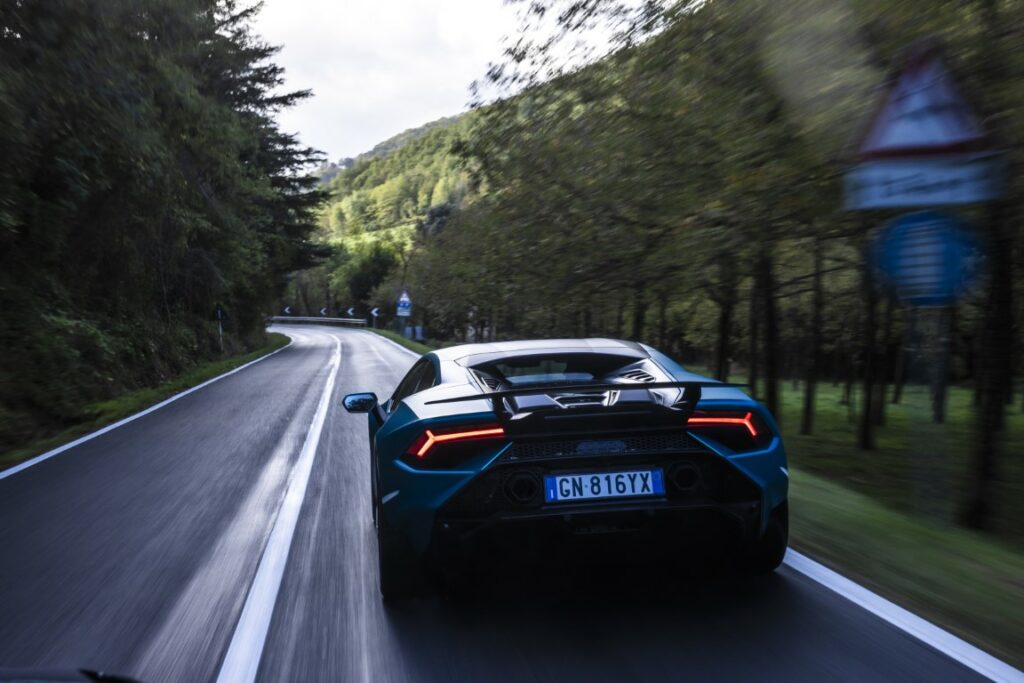
As with the Spyder, it’s a very easy car to drive around town, and feels more civilised thanks to the added refinement of a fixed roof. Visibility is decent, too, although the postal slot of a rear window means that my view from the mirror is restricted.
The roads draped over the hilly topography of the Italian countryside reveal a car that feels notably stiffer, lighter and more focussed. The coupé bodystyle and lack of a four-wheel-drive system mean the Tecnica is a considerable 163kg lighter than the Spyder. The engine, meanwhile, offers slightly more power than the Spyder’s, developing 631bhp with identical acceleration figures – likely because the Tecnica is rear-wheel drive.
Sport mode proves to be perfect for these twisty roads, providing fast, accurate steering and allowing the rear end just enough slip under power before the traction control safely reins things back in. I can feel the rear-wheel steering working in some of the tight, low-speed hairpins, and it gives the car sharp and nimble handling characteristics not typically associated with Lamborghini.
Straights provide a brief interlude between the corners. In Sport and Corsa modes, the throttle response feels instantaneous, and the off-beat scream of the V10 builds in anger until I’m forced to hit the brake pedal before the next corner. Roof or no roof, it remains one of the most exciting soundtracks in supercar history.
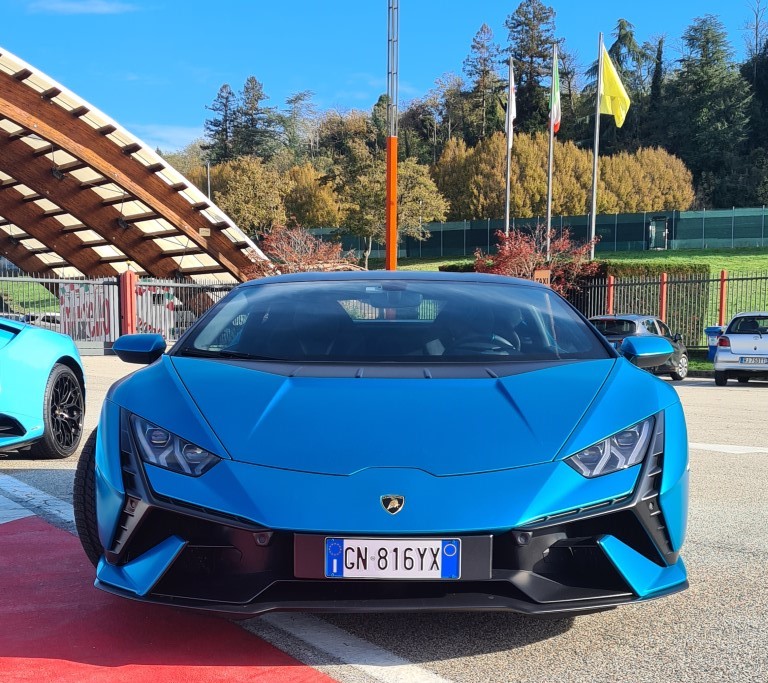
The residents of Porta San Francesco are undoubtedly taken aback as our lively procession makes its way through their terrifyingly narrow cobbled streets. The beautiful architectural backdrop of the Piazza del Priori offers the perfect setting for some Instagram fodder – and the locals agree. A growing crowd begins to encircle the cars, armed with smartphones, offering warm smiles and enthusiastic thumbs-ups as they eagerly take pictures. With photos snapped and pasta devoured, it is time to swap cars for the penultimate time. Excitingly, I will be embarking on the next quarter of the route in the limited-edition off-road Sterrato.
First unveiled in 2022, the Sterrato (‘dirt road’ in Italian) emerged this year as Lamborghini’s 60th anniversary present to itself, and represents the Huracán’s final send-off before it is succeeded by a new hybrid V8-powered model. Lamborghini originally committed to building 900 examples, yet overwhelming customer demand encouraged Sant’Agata to expand production to 1499 units.
The breadth of rally-inspired modifications demonstrates just how much work went into ensuring the Sterrato could perform off-road. Its ride height has been increased by 42mm, and the track has been widened by 30mm at the front and 34mm at the rear. There have also been a host of changes to the bodywork, which features spotlights, widened arches and bash plates, while a roof-mounted snorkel feeds clean air to the 5.2-litre V10.
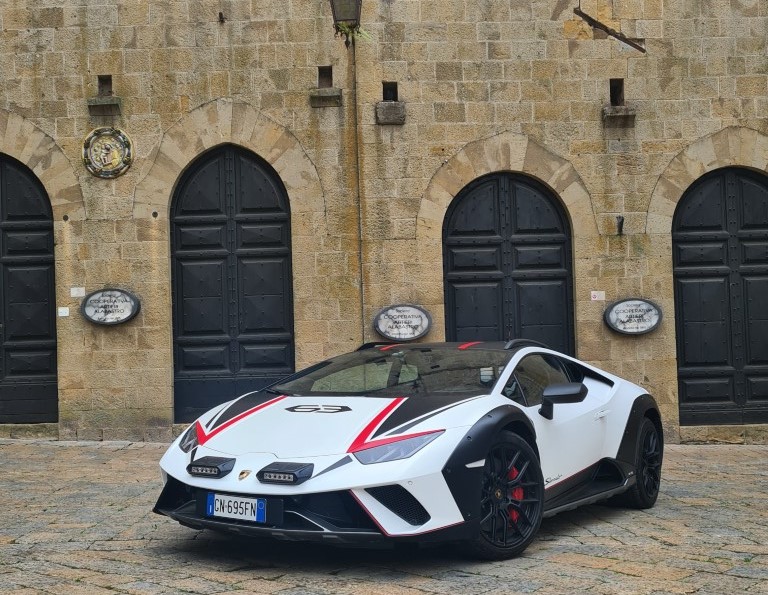
Inside, things are equally extreme. Grip tape lines the footwell in place of carpet, there’s bare carbonfibre door panels (which are optional) and a roll cage criss-crosses the space behind the bucket seats. The roof scoop feeding the engine means that there’s no rear window, so visibility is compromised.
Other features include off-road functionality for the central display, which incorporates a compass, an inclinometer and steering-angle graphics. Finally, the ANIMA driving mode selector switch on the steering wheel has a unique Rally mode setting in place of Corsa for off-road driving.
Naturally, the Sterrato feels immediately more compliant than the Tecnica on the cobbled streets of Porta San Francesco. Frustratingly, cobbled streets and poor, pothole-strewn roads are the toughest terrain the Sterrato faces during my time behind the wheel, although a brief run around a short off-road circuit at Vallelunga reveals that the car is immensely capable on the rough stuff, shrugging off vicious bumps with a rooster tail of dust in its wake.
Driving the Sterrato on normal roads certainly reveals a lot about the car’s character. It’s surprisingly refined and comfortable, and the bespoke Bridgestone Dueler tyres transmit far less road noise into the cabin than expected, during long slogs down the motorway. Increased body roll from softer springs and a higher centre of gravity are noticeable on twisty sections of Tarmac, although it’s far from what you would call wallowy – this is still a Lamborghini, after all.

That said, sacrifices still had to be made in the name of the Sterrato’s off-road talents. Top speed is limited to 162mph, largely because the raised ride height could make the car unstable at very high speeds. The throttle response is still electric, however, and shorter gear ratios mean the Sterrato doesn’t feel that much slower than its stablemates, despite developing 30bhp less than the rear-wheel-drive Tecnica. That impression is reinforced by a 0-62mph figure of 3.4 seconds.
I arrive at the final stop of the day feeling very impressed by the Huracán Sterrato. It’s clearly the most usable Lamborghini supercar ever built, while also being one of the most exciting – no mean feat. The combination of its four-wheel-drive grip and higher ride height allows its performance to be exploited almost anywhere, and would perfectly suit the potholed B-roads of the UK. Ironically, my final car of the day, the Huracán STO (Super Trofeo Omologato) will demonstrate this point even more than the Sterrato itself.
Darkness has fallen by the time I find myself clutching the STO’s key ahead of the final 114km journey to our hotel near Vallelunga Circuit, for the Lamborghini Super Trofeo World Finals. As the most extreme, performance-oriented Huracán ever built, the shark-finned STO is an intimidating car at the best of times; on dark, slick roads, the intimidation factor is magnified twofold.
Lamborghini has made no compromises when imbuing the STO with race-car DNA. Weight has been stripped out wherever possible; the window glass is thinner, there are no interior carpets, and everything but the roof and door skins are manufactured from carbonfibre. This, combined with the loss of its four-wheel-drive system, means the STO tips the scales at 1339kg – around 40kg less than the Tecnica.

The exterior, meanwhile, is almost totally new, with a single piece of bodywork creating the front bumper, bonnet and wings – which means my luggage will have to be sandwiched into the passenger footwell. Lamborghini calls this bodywork the Cofango, which is a portmanteau of two Italian words: cofano, meaning hood; and parafango, meaning fender.
There’s also a pair of louvres behind the front wheels that aid brake cooling, as well as bonnet vents that vent hot air from the front radiators. The rear is dominated by a huge, manually adjustable rear wing, the shark-finned engine deck and an aggressive diffuser. Resculpting the bodywork in such a way means the STO can produce up to 420kg of downforce – around 50 percent more than a Huracán Performante.
It’s fair to say, then, that the STO’s natural habitat is the racetrack, rather than rush hour on the autostrada. Despite this, it’s surprisingly easy to drive at low speed, although it’s easily the loudest and most uncompromising of the four cars in our convoy.
After around 40 minutes of stop-start motoring the traffic begins to ease, which means it is time for the STO to stretch its legs. Flick the ANIMA switch into Sport mode, mash the throttle pedal and I’m met with violent acceleration accompanied by an angry howl from that glorious V10. The histrionics have truly been turned up to 11 in this car, and the noise is bettered only by the open-roof experience of the Spyder.
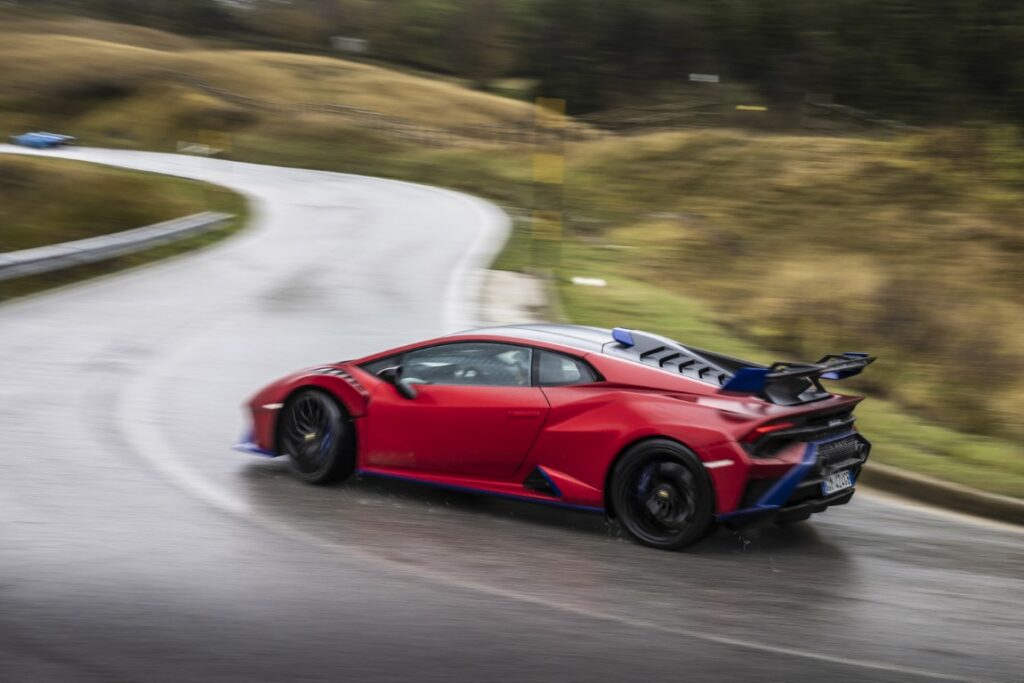
Totally addicted to the sound, I squeeze the accelerator whenever the opportunity arises. This, as it turns out, can get someone into a lot of trouble. Lulled into a sense of security by the four-wheel-drive grip of the Sterrato and Spyder, I flex my right foot while exiting a tunnel in Corsa mode, and the rear end twitches on the damp, exposed asphalt. Luckily, the combination of a rapid 13.4:1 steering ratio, torque vectoring and rear-wheel steering allows me to quickly correct the car and breathe a sigh of relief.
The final 10km of the journey to the hotel are comprised of dark, narrow and extremely bumpy Italian backroads. This proves to be the most challenging, attention-sapping part of the entire route. Here, it’s impossible to hide the STO’s race-car DNA as each bump presents the threat of a cringe-inducing scrape of the front splitter. Headlights on, my only option is to drive at a snail’s pace with the front axle lift engaged, and weave between some of the worst bumps and potholes I’ve ever seen. Mercifully, and after what feels like an expletive-filled eternity, I reach the hotel without damaging this very special machine. There’s no question the STO is wickedly fast, with 631bhp on tap, yet it is impossible to properly explore its deep dynamic capabilities on these real-world roads.
So, how has the Huracán line-up fared over 350 varied kilometres of Italy? Compared with other supercars, all four examples have felt endearingly old-school. The Huracán is an unapologetic ode to internal combustion, yet it’s been honed to such an extent that it still compares with the very best from McLaren and Ferrari – despite the fact it first entered production in 2013. So, after more than ten years since its launch, the Huracán has finally reached the end of the road and is due to be replaced in 2024 by the V8 hybrid as the marque manages its transition towards electrification.
The 350km adventure through Italy has made one thing patently clear: we will certainly miss the Huracán and its wondrous V10.
